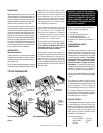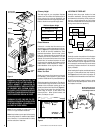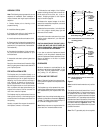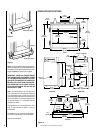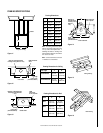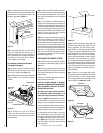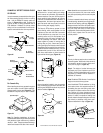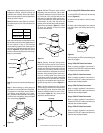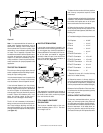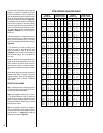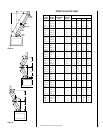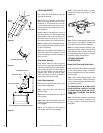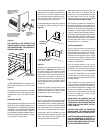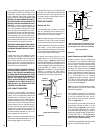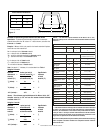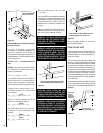
NOTE: DIAGRAMS & ILLUSTRATIONS NOT TO SCALE.
11
Figure 34
Note: It is recommended that all exterior ex-
posed metal fireplace components; such as
terminations, flashings, storm collars and/or
flue be painted with a premium quality, high
temperature, rust preventative paint designed
for metal. This is especially important when
installations are made in abnormally adverse or
corrosive environments; such as near lakes,
oceans or in areas with consistently high hu-
midity conditions. Consult the paint manufac-
turers instructions for proper preparation and
application.
TEN FOOT RULE SUMMARY
The minimum chimney height above the roof
and/or to adjacent walls and buildings is speci-
fied by all major building codes.
If the horizontal distance from the peak of the
roof is less then 10', the top of the chimney
must be at least 2' above the peak of the roof.
If the horizontal distance from the chimney
edge to the peak of the roof is more than 10' a
chimney height reference point is established
on the roof surface 10' horizontally from the
chimney edge. The top of the chimney must be
at least 2' above this reference point. In all
cases, the chimney cannot be less then 3'
above the roof at the edge of the chimney.
The 2' in 10' rule is necessary in the interest of
safety but does not ensure smoke-free opera-
tion. Trees, buildings, adjoining roof lines, ad-
verse wind conditions, etc., may require a taller
chimney should the fireplace not draft properly
(
see Figure 34
).
Figure 35
This suggestion is provided in the interest of
better operation. If the terminations are located
too close to each other, smoke may migrate
from one flue into the other.
FTF8 CHIMNEY COMPONENT
CALCULATIONS
The minimum installed height of the com-
pleted fireplace system is 15' 0". The maxi-
mum height is 60' 0".
To determine the number of chimney sections
and chimney components required, follow
these steps:
1. Determine total vertical height of the fireplace
installation. This dimension is the distance from
the surface the fireplace sets on to the point
where smoke exits from the termination.
2. Determine the number of chimney compo-
nents required, except chimney sections. This
would include firestop spacers, stabilizers, roof
flashing, etc.
3. The effective heights of the components are:
The Fireplace = 45-3/8"
FTF8-12 = 10-1/4"
FTF8-18 = 16-1/4"
FTF8-36 = 34-1/4"
FTF8-48 = 46-1/4"
FTF8-CTD Termination = 4"
FTF8-CT1 Termination = 12" to 18"
FTF8-CT2 Termination = 15" to 23"
FTF8-CTDT Termination = 12" to 18"
FTF8-CTT Termination = 6" to 14"
FTF8-ATT Termination = 8" to 14"
FTF8-S4 Stabilizer * = 3"*
* Required for every 30' of vertical chimney
and/or 10' of offset chimney.
4. Determine amount of chimney height re-
quired by subtracting total combined height of
all pre-selected components (fireplace and
chimney components from total desired height.)
Reference Vertical Elevation Chart and deter-
mine the number of chimney sections (quantity
and length) required.
SPECIAL OFFSET INSTRUCTIONS
To clear any overhead obstructions, you may
offset your chimney system using Security's
30° offset and return elbows. Use two elbows -
an offset elbow to initiate the offset and a return
elbow to terminate it. A 30° offset elbow, an-
gling in any direction, may be the first compo-
nent used off the top of the fireplace flue collar.
CTD
18"
18"
24"
24"
CTDT
CTDT
Less Than 10'
3'
Min
2' Min.
10'
3'
Min
MULTIPLE TERMINATIONS
If more than one termination is located in the
same chase or within the same general proxim-
ity, we suggest they should be separated in
distance at least 24" horizontally from flue cen-
ter to flue center and stacked or staggered
vertically at least 18" apart, from the termina-
tion of one smoke exit to the termination of
another smoke exit (
Figure 35
).



